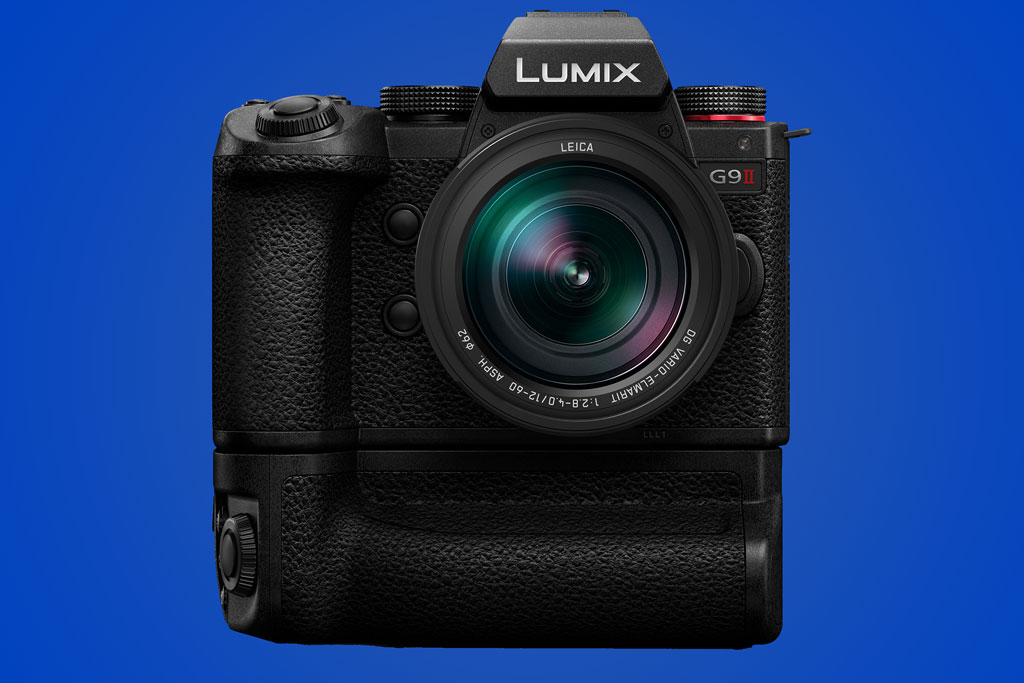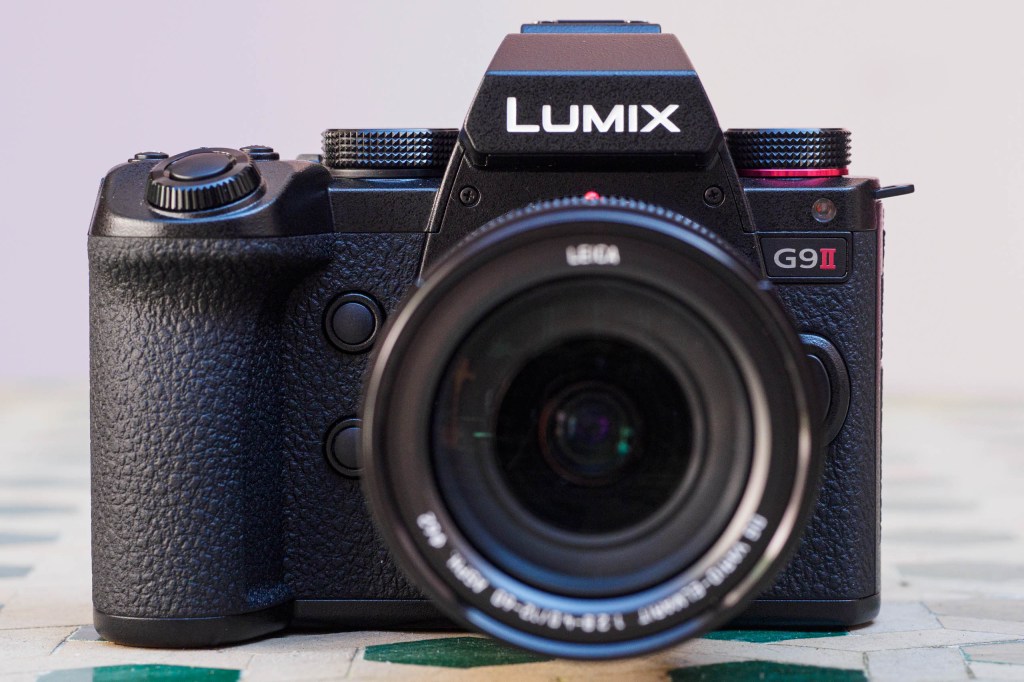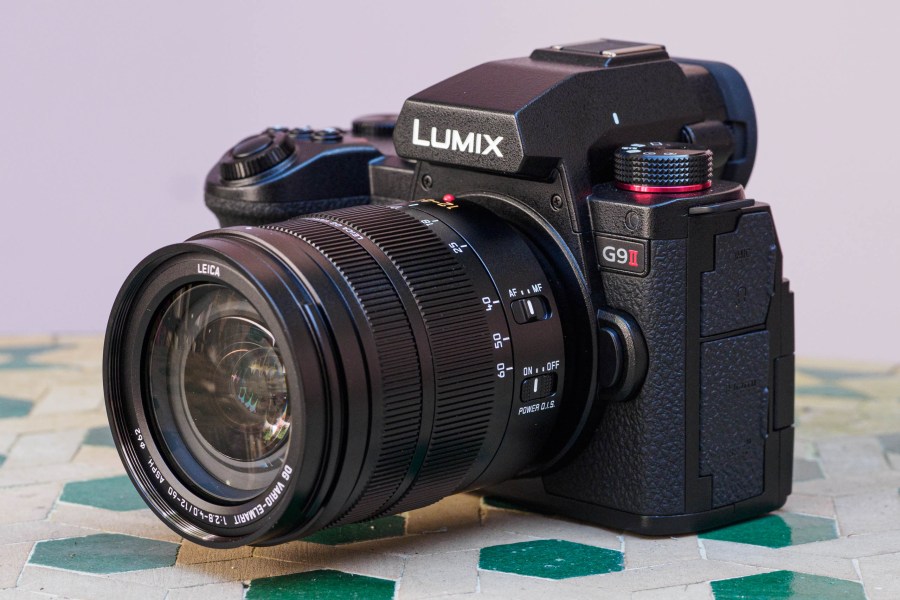Panasonic has launched a new Micro Four Thirds flagship camera, the Panasonic Lumix G9II. It’s capable of recording 25MP still images at up to 75 frames per second, and 5.7K video at 60fps. It becomes the firm’s first Micro Four Thirds model to boast phase detection autofocus, while also including subject recognition for human, animals, and cars/motorcycles.
Panasonic Lumix G9II at a glance:
- £1699 body-only
- £1899 with Lumix G 12-60mm F3.5-5.6 OIS lens
- £2249 with Leica DG 12-60mm F2.8-4 OIS lens
- 25.2MP Four Thirds sensor
- ISO 100-25,600 (standard)
- Up to 75 fps shooting
- 3.68m-dot, 0.8x OLED viewfinder
- 3in, 1.84m-dot vari-angle LCD
- 5.7K 60p and 4K 120p video
- 5-axis in-body image stabilisation, 8-stops
- Dual SD card slots
- Shipping November 2023

From the back, the G9II is almost indistinguishable from the S5II. Credit: Andy Westlake
In design terms, the G9II uses essentially the same body as the full-frame Lumix S5II, with just a few detail changes. It has an additional function button on the front, but no built-in cooling fan. Compared to the original G9 it has almost all the same controls, although not in exactly the same places. But there’s no top-plate status screen.
You can read all about the new Panasonic Lumix G9II in our hands-on first look review:
- Read our Panasonic Lumix G9II review: hands-on first look
- Updated Panasonic 100-400mm II and 35-100mm f/2.8 zooms
New Panasonic DMW-DG1 battery grip for G9II and S5II
Panasonic has also revealed a new DMW-DG1 battery grip, which fits the G9II, S5II and S5IIX. This provides a duplicate set of controls for portrait-format shooting, including front and rear dials; ISO, white balance, and exposure compensation buttons; AF-ON and Fn buttons; and an 8-way AF joystick.

Panasonic Lumix G9II fitted with the DMW-DG1 battery grip. Credit: Panasonic
It also holds a second battery for extended shooting durations. The Panasonic DMW-DG1 battery grip will cost £309.
Follow AP on Facebook, Twitter, Instagram, and YouTube.
From Panasonic:
The LUMIX G9II

Panasonic Lumix G9 II. Credit: Andy Westlake
“Capture the Decisive Moment”
- New Sensor and New Engine Boasting Outstanding Photographic Performance
- PDAF technology implemented in LUMIX G Series for the First Time
- Flagship Micro Four Thirds Model for Still Images with Improved High-Speed Performance and Ergonomics
London, UK, 12th September 2023 – Panasonic is proud to announce the launch of the LUMIX G9II digital mirrorless camera, equipped with a new sensor and Phase Detection Auto-Focus (PDAF) technology. The LUMIX G9II is the first camera in the Micro Four Thirds LUMIX G Series to feature PDAF technology.
In line with the growing need to produce highly creative artwork and photography using diverse methods, this new model creates high-resolution, high-quality images and rich colors straight out of camera. Furthermore, with a new auto-focus technology that combines Panasonic’s accumulated expertise in recognition technology with PDAF, and a high-speed burst shooting mode that ensures decisive moments are always captured, this new model boasts significantly improved power and high-speed performance. The camera supports photographers from various fields using a system that can be combined with the compact and lightweight LUMIX G Micro Four Thirds lenses for ultimate flexibility.
The new 25.2-megapixel Live MOS Sensor and new engine produce high-resolution images in outstanding quality with rich color tones, while the hybrid PDAF technology enables accurate auto-focus and high-speed tracking of fast-moving subjects. Moreover, burst shooting at 60 fps in AFC mode and SH pre-burst recording*1 that begins before the shutter is released ensures that the decisive moment is always captured, even with dynamically moving subjects.
LUMIX’s popular image stabilization system is further improved, combining 8-stop*2 B.I.S. (Body Image Stabilizer), 7.5-stop*3 5-axis Dual I.S. 2, and advanced Active I.S. for incredible video image stabilization. Together, these functions provide even greater support for handheld shooting of dynamic scenes that would previously have been difficult to capture. In addition, creators can enjoy enhanced monochrome photo styles with new LEICA Monochrome and REAL TIME LUT for preferred color settings. Through this next-generation digital mirrorless camera, Panasonic intends to respond to the needs of creators who are pursuing methods of creative expression that go beyond the boundaries of photography and videography.
The LUMIX G9II will be available in November 2023 from RRP £1,699.
Main Features:
- Equipped with a new sensor, new engine, and the first PDAF implementation in LUMIX G Series for outstanding photographic performance and high-speed response
- New 25.2-megapixel Live MOS Sensor for high resolution and high-speed response (13+ stop*4 V-Log/V-Gamut, Dynamic Range Boost*5)
- New engine that achieves natural, three-dimensional textured images and ensures high-speed processing of high bitrate video
- Use of new AI-powered recognition technology (developed using deep learning technology) for real-time auto-focus recognition that now recognizes cars, motorcycles, and animal eyes for improved precision in subject recognition
- Advanced high-speed performance to ensure decisive moments is always captured
- Burst shooting at 60 fps in AFC mode and reinforced buffer memory for continuous burst shooting over three seconds for ensuring the capture of targeted moments
- SH pre-burst recording*1 that can begin shooting up to 1.5 seconds before the shutter is released and take approximately 113 consecutive shots
- Robust image stabilization system with 8-stop*2 I.S. (Body Image Stabilizer), 7.5-stop*3 5-axis Dual I.S. 2, with perspective distortion correction for video, and high mode for advanced Active I.S.
- Highly-mobile camera system combined with the compact, lightweight, and diverse range of LUMIX G Series lenses
- New modes expand the possibilities of creative photography
- REAL TIME LUT function enabling personalized color expression through use of LUT files
- Enhanced monochrome mode with newly added LEICA Monochrome for deep black-white contrasts
- Hand-held 100-megapixel High Resolution mode and Live View Composite mode to expand the range of photographic options
- A launching point for video creation
- 4:2:0 10-bit 5.8K (4:3) full sensor recording/ 5.7K (17:9) enables flexible framing options for various social media formats
- 4:2:0 10 bit C4K/4K 120p/100p enables slow motion videos
- Apple ProRes*6 video, which delivers high image quality at low compression, reducing the load on the computer during post-production and allows non-linear editing without transcoding, streamlining your workflow from start to finish.
- Recording and playback are supported using an external SSD via USB
- Active I.S. Technology corrects shake when shooting on the move
*1 When the ambient temperature is high or Pre-Burst recording is performed continuously, even if you press the shutter button halfway, Pre-Burst may not operate to protect the camera from overheating. Wait until the camera cools down.
*2 Based on the CIPA standard [Yaw/Pitch direction: focusing distance f=60mm (35mm film camera equivalent f=120mm), when H-ES12060 is used.
*3 Based on the CIPA standard [Yaw/Pitch direction: focusing distance f=140mm (35mm film camera equivalent f=280mm), when H-FSA14140 is used.
*4 When shooting video at a setting of over 60 fps (including slow and quick mode), the luminance range provides 12+ stops.
*5 The dynamic range boost will not function when shooting video at a setting of over 60 fps (including slow and quick mode), when using the SH burst function for still images, and when combining slow shutter speeds of more than 1/15 seconds with ISO.
*6 Apple and ProRes are trademarks or registered trademarks of Apple Inc. in the United States and/or other countries.- Please see the website for video performance information, details, and specifications of the LUMIX G9II.







